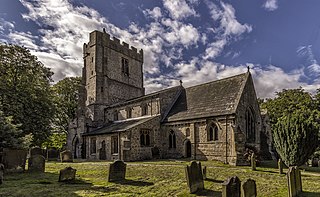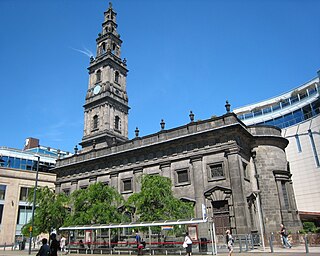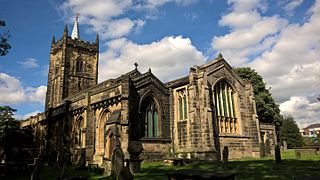
Kirby Hill, historically also known as Kirby-on-the-Hill, is a village and civil parish in the Richmondshire district of North Yorkshire, England. The village is about 1 mile (1.6 km) south of Ravensworth and about 4 miles (6 km) north-west of the town of Richmond.

Richmond Hill is a district of Leeds, West Yorkshire, England. The district lies a mile to the east of the city centre between York Road, East End Park and Cross Green. The appropriate City of Leeds ward is Burmantofts and Richmond Hill.

Leeds Cathedral, formally the Cathedral Church of St Anne, commonly known as Saint Anne's Cathedral, is the cathedral of the Roman Catholic Diocese of Leeds, and is the seat of the Roman Catholic Bishop of Leeds. It is in the city of Leeds, West Yorkshire, United Kingdom. The city of Leeds does not have a Church of England cathedral although it is in the Anglican Diocese of Leeds. The cathedrals of the Anglican diocese are in Ripon, Wakefield and Bradford. The city instead has a Minster which is similar to nearby Dewsbury Minster and Halifax Minster, all of which are parish churches.

St Chad's Church, Far Headingley is the parish church of Far Headingley in Leeds, West Yorkshire, England. The church is Grade II* listed in Gothic Revival style. The dedication is to Chad of Mercia, who was bishop of York and died in AD 672. It is set back from the busy Otley Road, with a cricket field and the parish war memorial nearer the road.

St Paul's Church overlooks the River Dee in Boughton, Chester, Cheshire, England. The church is recorded in the National Heritage List for England as a designated Grade II* listed building, and, before its closure, was an Anglican parish church in the diocese of Chester, the archdeaconry of Chester and the deanery of that diocese. In the series Buildings of England, the architectural historian Nikolaus Pevsner stated that he regarded it as "the boldest of Douglas' church designs".

Wakefield Cathedral, or the Cathedral Church of All Saints in Wakefield, West Yorkshire, England, is a co-equal Anglican cathedral with Bradford and Ripon Cathedrals, in the Diocese of Leeds and a seat of the Bishop of Leeds. Originally the parish church, it has Anglo Saxon origins and, after enlargement and rebuilding, has the tallest spire in Yorkshire. Its 247-foot (75 m) spire is the tallest structure in the City of Wakefield. The cathedral was designated a Grade I listed building on 14 July 1953.

The Church of St Mary the Virgin in Middleton, West Yorkshire, England is an active Anglican parish church in the Armley deanery in the archdeaconry of Leeds and the Diocese of Leeds. The church and its lych gate are Grade II listed buildings.

St John the Evangelist's Church is a redundant Anglican church in the centre of the city of Leeds, West Yorkshire, England. It is recorded in the National Heritage List for England as a designated Grade I listed building, and is under the care of the Churches Conservation Trust. The architectural historian Nikolaus Pevsner refers to it as "the only church at Leeds of more than local interest".

Holy Trinity Church lies on Boar Lane in Leeds, West Yorkshire, England. It is a Grade I listed Church of England parish church in the Parish of Leeds St George in the Diocese of Leeds. It was built in 1722–7, though its steeple dates from 1839. Holy Trinity is in the evangelical church tradition of the Church of England.

Kelly & Birchall, a partnership between Edward Birchall and John Kelly (1840–1904), was an architectural practice based in Leeds, England, from 1886 to 1904 and specialising in churches in the Italianate and Gothic Revival styles.

William Swinden Barber FRIBA, also W. S. Barber or W. Swinden Barber, was an English Gothic Revival and Arts and Crafts architect, specialising in modest but finely furnished Anglican churches, often with crenellated bell-towers. He was based in Brighouse and Halifax in the West Riding of Yorkshire. At least 15 surviving examples of his work are Grade II listed buildings, including his 1875 design for the Victoria Cross at Akroydon, Halifax. An 1864 portrait by David Wilkie Wynfield depicts him in Romantic garb, holding a flower. He served in the Artists Rifles regiment in the 1860s alongside Wynfield and other contemporary artists.

Mount St Mary's Church or the Church of the Immaculate Virgin Mary is a Grade II* listed building and a redundant Roman Catholic church in Leeds, West Yorkshire, England. It was founded in 1851 and designed by Joseph Hansom, with extensions by Edward Pugin. It is next to Mount St Mary's Catholic High School, Leeds.

St. Stephen's Church is a Church of England church in Kirkstall, Leeds. The church has been Grade II listed since 5 August 1976.

St Mary's Church in Whitkirk, Leeds, West Yorkshire, England is an active Anglican parish church in the archdeaconry of Leeds and the Diocese of Leeds.

The Grade I listed, mainly Norman Church of Saint John the Baptist in Adel, Leeds, West Yorkshire, England has been described by Nicholas Pevsner as 'one of the best and most complete Norman churches in Yorkshire'. It is most notable for its magnificent south doorway with surrounding carvings, and highly carved Norman chancel arch. There is also a replica of a 13th-century sanctuary ring on the exterior of the south door, the original having unfortunately been stolen in 2002. The church is an active Anglican parish church in the archdeaconry of Leeds and the Diocese of Leeds.

Robert Mawer was an architectural sculptor, based in Leeds, West Yorkshire, England. He specialised in the Gothic Revival and Neoclassical styles. He created the Neoclassical keystone heads on St George's Hall, Bradford and on Moorland's House, Leeds, and was working on the keystone heads at Leeds Town Hall when he died. He was a founding member of the Mawer Group of Leeds architectural sculptors, which included his wife, Catherine Mawer, his son Charles Mawer, and his apprentices William Ingle, Matthew Taylor and Benjamin Payler, who all became sculptors with their own careers. Many of the buildings enhanced with sculpture by Robert Mawer are now listed by Historic England.

The Church of All Saints, Harlow Hill, Harrogate, North Yorkshire, England, is a grade II listed mission church, or chapel of ease, completed in 1871 on land donated by Henry Lascelles, 4th Earl of Harewood, within the parish of St Mary. It was consecrated by the Bishop of Ripon in 1871. The building was designed with a round bell tower, in Gothic Revival style, by Isaac Thomas Shutt and Alfred Hill Thompson. After some years of closure due to structural problems, as of 2014 it was being restored for use by a funeral director's company.

St Augustine's Church, Wrangthorn, usually referred to as simply Wrangthorn, is the church of the parish of Woodhouse and Wrangthorn, Leeds, West Yorkshire, England. It is near Hyde Park Corner at the top of Woodhouse Moor. It shares a benefice and clergy with St George's Church in the city centre, although the parishes remain separate. It was paid for by the Leeds Church Extension Society in 1866 and completed in 1871. The church, which is a Grade II listed building is on a ridge of land between Meanwood Beck and the Aire Valley, on the north-west side of the city. Its architect, James Barlow Fraser (1835–1922), took advantage of this prominent location by including a three-stage pointed steeple; its blackened stone is a local landmark. The church is built in local gritstone ashlar in the Gothic Revival style and is adjoined by the smaller church hall of 1934.

Headingley Hill Congregational Church is a redundant Unitarian church at the corner of Headingley Lane and Cumberland Road, in the Headingley area of Leeds, West Yorkshire, England. The church, which is a Grade II listed building, was designed in the Gothic Revival style by Cuthbert Brodrick and completed in 1866. It was the only church to have been designed by Brodrick, who is noted for Leeds Town Hall and the Corn Exchange.
Burmantofts and Richmond Hill is a ward in the metropolitan borough of the City of Leeds, West Yorkshire, England. It contains 15 listed buildings that are recorded in the National Heritage List for England. Of these, one is listed at Grade I, the highest of the three grades, one is at Grade II*, the middle grade, and the others are at Grade II, the lowest grade. The ward includes the areas of Burmantofts, Cross Green, and Richmond Hill. The listed buildings consist of five churches and associated structures, a former school and an active school, a former mill, a former library and public baths, and two monuments in Beckett Street Cemetery.
























